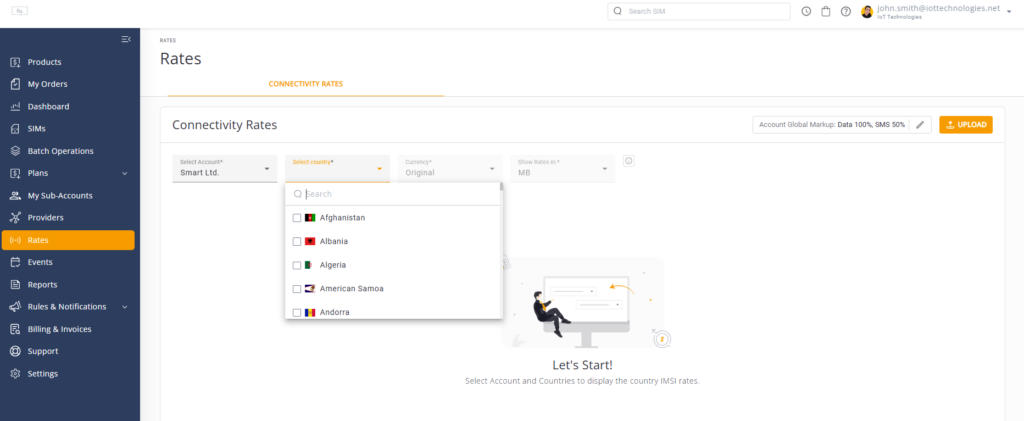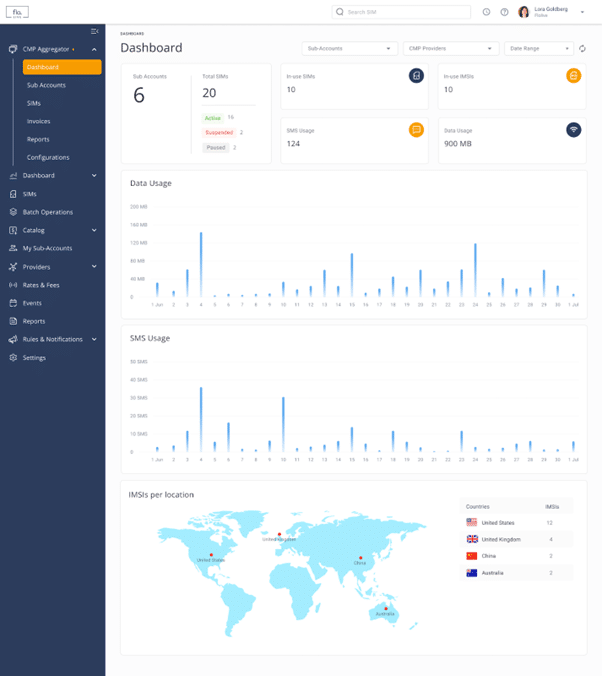
Page Contents
A Connectivity Management Platform (CMP) is a system designed to manage and optimize the connectivity of deployed devices, particularly in the context of the Internet of Things (IoT). CMPs offer tools and services to manage the lifecycle of SIM cards, monitor network usage, and ensure secure and reliable communication between devices and networks. They provide a centralized interface for deploying, monitoring, and managing networks, along with features for billing, troubleshooting, and analytics.
Here are some key features and functions of a CMP:
- SIM management: CMPs enable the provisioning, activation, suspension, and management of SIM cards, including monitoring data usage and managing contracts.
- Network monitoring: They offer real-time visibility into network performance, including data usage, signal strength, and connectivity status.
- Troubleshooting: CMPs provide tools to diagnose and resolve connectivity issues, helping to minimize downtime and improve device reliability.
- Security: They include features such as network/SIM-layer controls, including private/custom APNs, IP allow/deny, IMEI/SUPI binding, VPN/IPsec, per-SIM firewalls, and anomaly detection.
- Billing and reporting: CMPs can automate billing processes and generate reports on network usage and costs.
- Integration: They can integrate with other systems, such as CRM and ERP platforms, to provide a holistic view of the IoT ecosystem.
A connectivity management platform is used by a wide range of organizations in the industry. These include:
- Network Operators: Mobile network operators (MNOs) and Mobile Virtual Network Operators (MVNOs) use CMPs to manage the connectivity of mobile devices, SIM cards, and other network-connected devices. They offer CMP services to enterprise customers for managing large-scale IoT deployments.
- IoT Service Providers: Companies that provide IoT solutions and services use CMPs to manage the connectivity of their devices, ensuring reliable and secure communication across networks.
- Enterprises: Enterprises need control of deployed devices and insight into device behavior. These enterprises sit in key verticals including asset and supply chain management, logistics, healthcare, agriculture, smart cities, and more.
Benefits of a Connectivity Management Platform
A connectivity management platform provides essential capabilities for businesses deploying IoT devices at scale.
Here are some of the main advantages:
- Service continuity: Supports redundancy and failover mechanisms to minimize downtime in case of network issues.
- Improved efficiency: CMPs simplify the management of connected devices, reducing manual effort and improving operational efficiency.
- Reduced costs: By optimizing network usage and identifying potential issues early, CMPs can help reduce costs associated with connectivity and device management.
- Enhanced reliability: CMPs enable proactive monitoring and troubleshooting, leading to improved device uptime and reliability.
- Scalability: CMPs can easily scale to accommodate growing numbers of connected devices, making them suitable for both small and large deployments.
- Better insights: CMPs provide valuable data on device performance and network usage, enabling businesses to make informed decisions and optimize their IoT deployments.
- Improved security: Enforces network policies, supports secure provisioning, and can detect anomalous behavior.
- Enhanced visibility: Offers real-time and historical analytics on device performance and connectivity status.
- Global reach: Allows seamless international deployments via multi-network and roaming capabilities.
The Evolution of Connectivity Management Platforms
Legacy platforms have largely been in use by MNOs and MVNOs, which are not entirely agile enough to support the complex requirements of IoT, as well as being cumbersome, difficult to integrate, and expensive. There can be a significant lack of features, including billing and support, which creates a need for additional integrations and management.
The demand for a more nimble, feature-rich CMP has grown alongside the demands of IoT with its many requirements to support a wide range of connectivity technologies, devices, and applications. Additionally, the cost of connectivity continues to be driven down, leading MNOs, MVNOs, and otherwise to look outside of cost-intensive legacy CMPs.
There are certain functions within a CMP that are table stakes – SIM management, a user interface, and an API. But the new CMP emerging to meet the needs of IoT and the major players in the industry contains much more and is much more well-suited for this new generation of IoT.

Types of IoT Connectivity Management Platforms?
There are two main types of connectivity management platforms (CMPs): Holistic CMPs that offer feature rich functionality and more inherent capabilities for IoT projects, and what we’ll call thin CMPs, those that act as an orchestration layer to streamline the existing legacy core network and applications of the mobile operator.
Thin CMPs
Thin Connectivity Management Platforms are lightweight orchestration layers that integrate with a mobile operator’s existing legacy infrastructure. Rather than providing end-to-end connectivity functionality themselves, these platforms are reliant on the operator’s core network and business support systems (BSS). Their primary role is to streamline and automate tasks like SIM provisioning, usage monitoring, and connectivity policies, all without needing to overhaul the operator’s backend systems.
However, this reliance on legacy components can introduce a number of limitations. First, mobile operator systems were originally designed for human mobile users, not the unique and diverse needs of IoT devices. This misalignment creates challenges in terms of scaling, customization, and latency handling. Secondly, when using a thin CMP, any new IoT deployment often requires integration work with both the operator’s core network and potentially third-party systems, which can be time-consuming, expensive, and error-prone.
The result is a slower time to market, reduced agility, and increased operational complexity. These platforms may be suitable for operators seeking to layer IoT connectivity services on top of existing infrastructure with minimal change. But for organizations prioritizing flexibility, scalability, and faster go-to-market capabilities, thin CMPs often fall short of expectations.
Holistic CMPs
Thin Connectivity Management Platforms will utilize the core network of the mobile operator, and their Business Support Systems, or perhaps even third-party systems that come from another provider altogether. This will require you to manage complex integrations before you can go to market. In contrast, a holistic CMP has both of these attributes of your IoT project included, and built for purpose – ready for IoT needs from day one, and prepared for any requirements of scale.
Read this article if the integrations of your Connectivity Management Platform are slowing you down
Let’s look at the key capabilities of a holistic CMP:
- Core network: An IoT core network that’s separated from the consumer core network just makes sense. Your IoT devices don’t act like consumer devices – they have totally different usages, and so you need to account for packet sizes, bulk data transfer, different requirements of latency and throughput, and many other adaptations. Critical devices will need granular policy creation and automation in place. This ensures IoT devices don’t risk impacting your main business.
- Business support systems (BSS) suited for IoT: A legacy BSS built for mobile subscribers just doesn’t suit IoT. Mobile systems are built to assume each user has one or two devices, while IoT users may have hundreds or thousands. IoT devices consume data in a totally different way, and low ARPU devices can’t be monetized in the way a mobile phone can.
When you’re creating a rate plan for IoT – you need a BSS that has the functionality in place. Advanced billing and rating as part of your Connectivity Management Platform means you can invoice multiple levels of users (your customer’s customers), and deal with IoT on a global scale – supporting multiple currencies, taxation, compliance laws, and more.
Owning your own BSS is also a matter of control. When you need to make a change, you don’t have to contact the mobile operator and wait for their service. You can simply log in and use codeless development tools to just get what you need done, done.
How to Choose
If you’re in the market for an IoT connectivity platform that suits long term needs, look for:
- Comprehensive IoT device management: The ability to provision SIMs over-the-air, including activating and deactivating them in real-time and assigning new SIM profiles without needing to reset the device, as well as granular control over data consumption, permissions, and usage.
- Agnostic compatibility: Connectivity technologies are changing all the time, so you need to know your CMP works with all IoT devices, no matter which form factor your SIMs come in. Device connectivity shouldn’t rely on any specific SIM card, or any specific cellular technology. Think 2G-5G, CAT-M and beyond and 2FF to MFF2.
Inherent security: When you’re managing devices over an IoT network, you need always-on cellular connectivity and visibility. Look for a CMP that exposes network operator slicing for businesses with added needs in terms of security, and who offers tunneling and filtering for traffic using smart firewalls and access policies.
floLIVE’s Holistic CMP for IoT

floLIVE offers a holistic, cloud-native CMP-as-a-service that provides a centralized interface and a “single pane of glass” for customers. This platform is designed to manage connectivity, devices, data, and applications within an IoT ecosystem. It tightly integrated with core network and Business Support System (BSS) functionalities, offering advantages like reduced complexity, faster time-to-market, and streamlined operations.
The floLIVE CMP offers full visibility and ultimate control over global IoT deployments, enabling users to monitor devices, access real-time network events and usage, troubleshoot issues, and manage SIMs and connectivity from one place.
Key features of the floLIVE CMP include:
- Supports a multi-tenant platform with a built-in hierarchical model.
- Centralized Management and Single Pane of Glass for global visibility and control.
- Real-Time Monitoring and Alerts providing visibility into SIM status, location, usage, and network events.
- SIM Management throughout the lifecycle, including activation, suspension, profile changes, and support for Multi-Carrier SIMs and Multi-IMSI.
- Billing and Invoicing Management, integrated into the CMP, enabling management of billing activities, flexible models, and sub-account financial management.
- Usage Analytics and Reporting available through the portal or API.
- Troubleshooting Tools that consolidate information from the core network and billing to aid in quick problem resolution.
- Self-Care Function for enterprises to identify and resolve SIM issues.
- API Access (REST API suite) to extend functionality and integrate with external systems.
- eUICC Management and integration with RSP platforms.
- Custom APN management for enhanced security and control.
- White-labeling capabilities to customize the web portal appearance.
- Compliance and Regulatory Support.
- Security features including data encryption, threat detection, and secure VPN/firewalls.
- Steering Management allows users to create and manage Steering Trees.
- SMS Management supports sending, receiving, monitoring, and tracking SMS messages via the UI or API.
- VoLTE Capabilities Management integrated into the CMP for managing call preferences, billing, and reporting.
- Functions as a CMP Aggregator capable of managing multiple MNO eSIM and IMSI profiles from the single interface.

Want to learn more? Reach out to get the conversation going.




